Let me teach you how to brown butter. Brown butter is melted butter with a nutty and bold flavor brought on by gently cooking it on the stove. You can use this one-ingredient wonder as a sauce or as an ingredient in endless sweet or savory recipes.
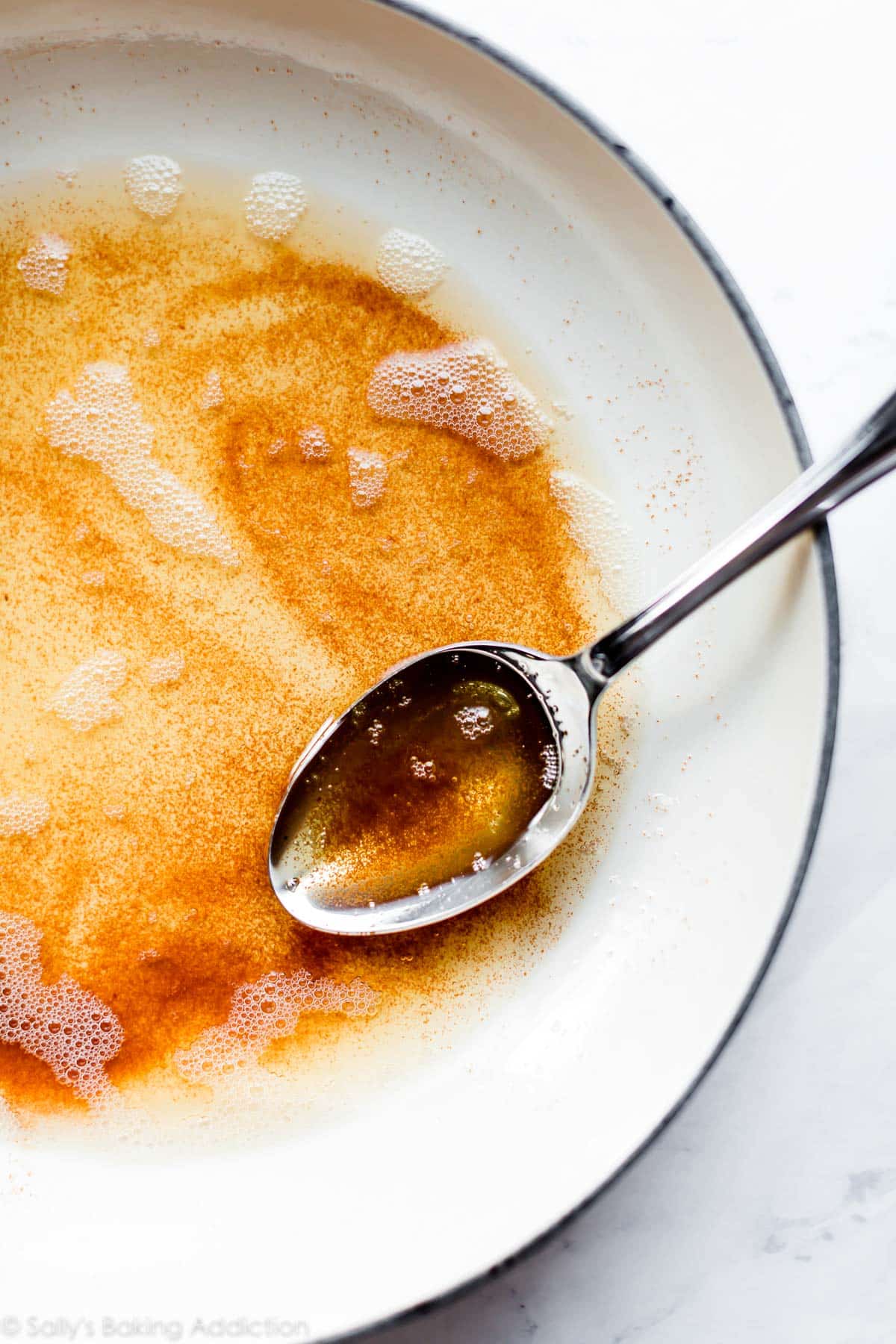
Here’s a detailed tutorial teaching you how to brown butter!
What Is Brown Butter?
Brown butter (buerre noisette) is a classic French staple in the kitchen. It’s melted butter with an accelerated flavor brought on by gently cooking it. It’s a one-ingredient wonder, vastly improving any dish or recipe where it’s used. In less than 10 minutes, butter sizzles, foams, and gently cooks into a nutty and caramelized flavored ingredient you can use as a sauce over pasta, meat, or vegetables; or in dessert recipes like brown butter sugar cookies, brown butter apple blondies, and brown butter pound cake.
Because of its versatility (and because it’s so delicious!), browning butter is a simple kitchen skill anyone can and should master. Let me show you how.
Video Tutorial
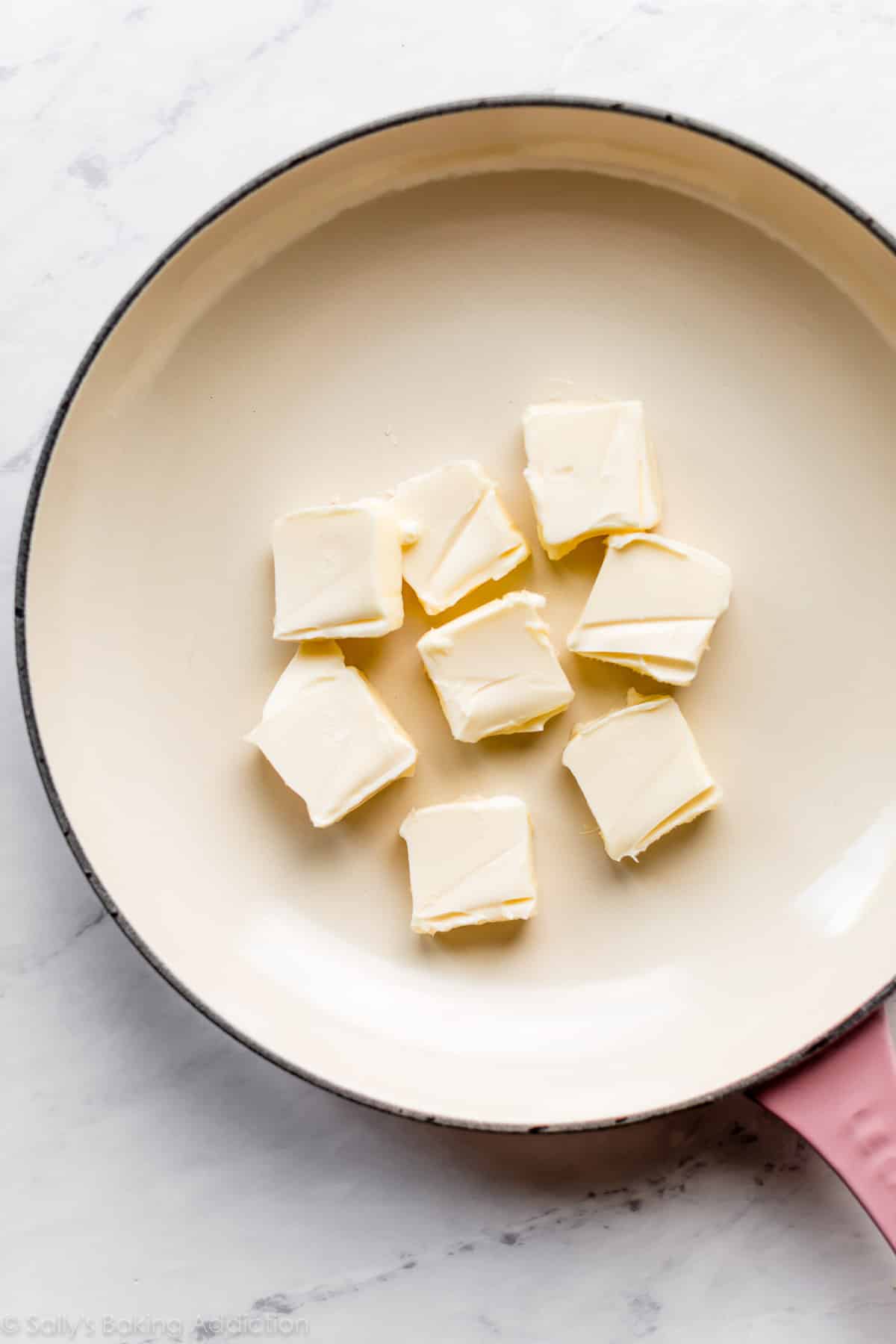
How to Brown Butter
Here are the items you need:
- Butter: You can use unsalted or salted butter, but make sure it’s cut into pieces so it cooks evenly. If the butter is frozen or too cold, it will splatter and easily burn. Take it out of the refrigerator about 20–30 minutes before starting.
- Pan: Use a light-colored pan so you can see when the butter has browned.
- Something to stir it with: A wooden spoon, silicone whisk, or rubber spatula work.
Browning butter is pretty quick. Place the pieces of butter in your light-colored pan. Turn the stove heat to medium. Medium heat ensures the butter cooks evenly, an important factor in the success of this easy process. Begin stirring to move the butter around as it melts. Once melted, the butter will begin to foam and sizzle around the edges. Keep stirring. In about 5–8 minutes from when you started (depending on the amount of butter you used), the butter will turn golden brown. The foam will slightly subside and the milk solids on the bottom of the pan will toast. It will smell intensely buttery, nutty, and rich.
Brown Butter Can Burn
There are only a few seconds between brown butter and burnt butter, so keep your eye on the stove the entire time. Don’t walk away and don’t stop stirring! Once some foam begins to dissolve and you notice the specks on the bottom of the pan have browned, immediately remove the pan from heat and pour the butter into a heatproof bowl to stop the cooking process. If left in the hot pan, the butter will burn. Burnt butter is bitter and unappetizing, a far cry from decadent browned butter.
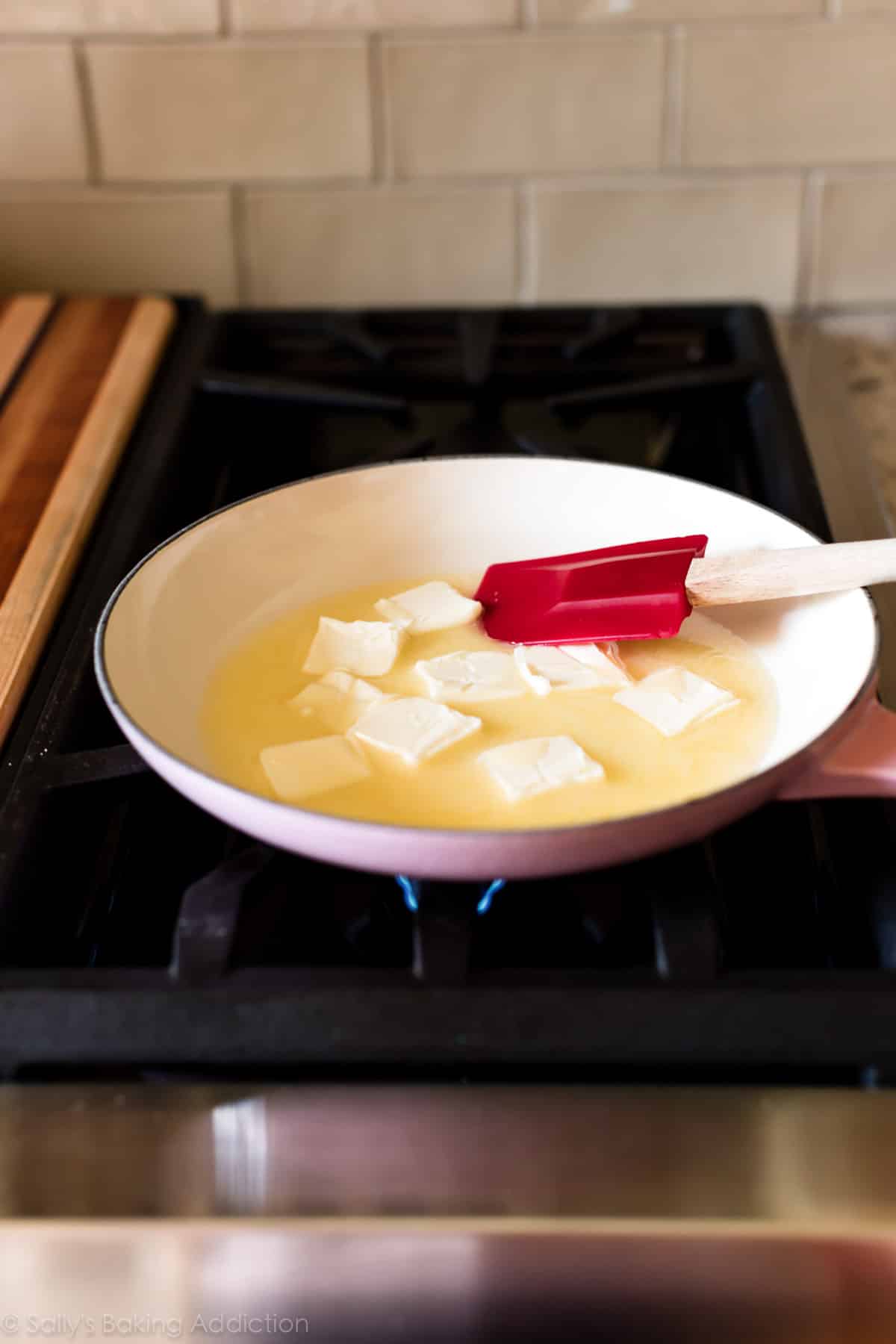
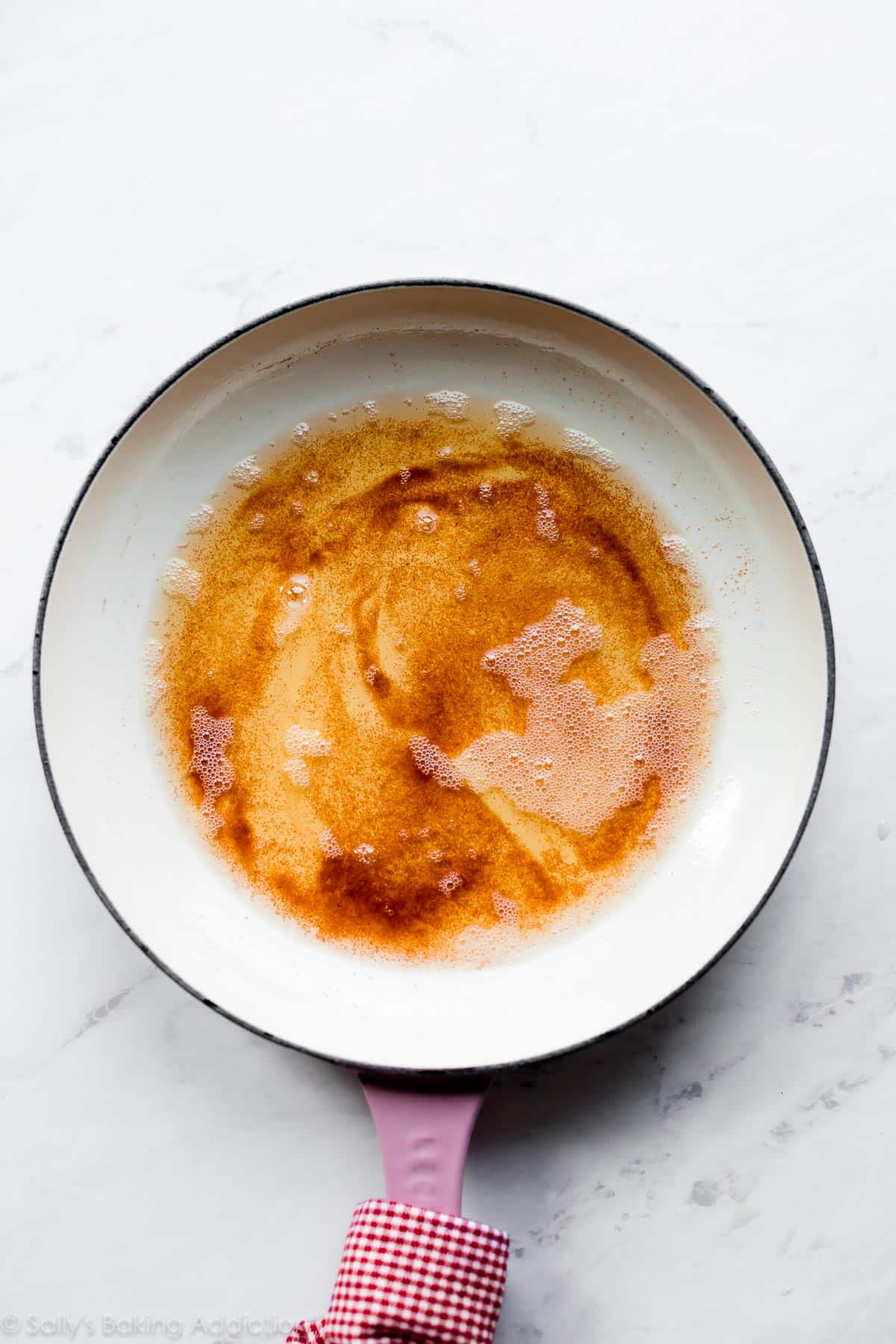
What Are the Brown Specks in Brown Butter?
Brown specks in brown butter are toasted milk solids. They’re actually where most of the flavor comes from, so make sure you scrape those out of the pan along with the liquid butter. Don’t strain out the specks. Trust me, you want it all in your recipe!
Is There a Loss of Moisture?
Yes. Some of the liquid evaporates during the cooking process, so always measure the brown butter after you cook it. If a recipe calls for “1/2 cup butter, melted” or “1/2 cup melted butter” and you’re using browned butter instead, make sure you have 1/2 cup (8 Tablespoons) of browned butter for the recipe. This may mean that you need to brown 8 and 1/2 or 9 Tablespoons of butter or, depending on the recipe, add a Tablespoon or 2 of milk. See my Brown Butter Chocolate Chip Cookies as an example.
3 Success Tips for Browning Butter
- Cut the Butter Into Pieces: This promises the butter will cook evenly.
- Don’t Stop Stirring: Again, this ensures the butter will cook evenly.
- Use a Light-Colored Pan: We can spot exactly when the butter has browned (and before it burns!) if we use a light-colored pan. You can use a pot, but I prefer a skillet. I’m using a Le Creuset cast iron fry pan in these photos, but a stainless steel pan or any other light-colored pan are excellent too.
Substituting Brown Butter
You can use brown butter in mostly any recipe that calls for melted butter. See Is There a Loss of Moisture? above. If a baking recipe calls for softened butter and you want to substitute brown butter instead, make sure it cools and solidifies first. It’s likely that the baking recipe calls for creaming butter and sugar together and you can’t cream melted brown butter. See Brown Butter Chocolate Chip Cookies as an example.
More Uses for Browned Butter
- Brown Butter Chocolate Chip Cookies
- Brown Butter Sugar Cookies
- Banana Layer Cake
- Brown Butter Pumpkin Oatmeal Cookies
- Peach Bundt Cake
- Apple Blondies
- Brown Butter Berry Tea Cakes
- Pecan Sugar Cookies
- Dark Chocolate Pecan Cookies
- Use as a dip for soft pretzels, bread, lobster, crab, or shrimp.
- Pour over popcorn, pasta, cooked vegetables, or potatoes.
- Stir a couple Tablespoons into mashed potatoes, sauce, or soup.
- Eat it with a spoon. Kidding! (Or am I?)
I hope this tutorial has been helpful for you!
Print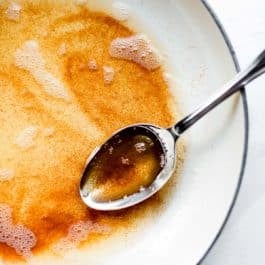
How to Brown Butter
- Prep Time: 1 minute
- Cook Time: 10 minutes
- Total Time: 10 minutes
- Yield: 1/2 cup
- Category: Topping
- Method: Cooking
- Cuisine: American
Description
Brown butter is melted butter with a nutty and bold flavor brought on by gently cooking it. You can use this one-ingredient wonder as a sauce or as an ingredient in endless sweet or savory recipes. Read success tips above and recipe Notes below before beginning.
Ingredients
- 1/2 cup (8 Tbsp; 113g) butter, cut into 1-Tablespoon-size pieces*
- light-colored pan or skillet
Instructions
- Preliminary note: Browning butter is pretty quick, so don’t leave the stove unattended. Have a heatproof bowl next to the stove ready to go for step 3.
- Place the butter in a light-colored pan over medium heat. Medium heat ensures the butter cooks evenly, an important factor in this process. Stir the butter the entire time to keep it moving. Once melted, the butter will begin to foam and sizzle around the edges. Keep stirring. In about 5–8 minutes from when you started (depending on the amount of butter you used), the butter will turn golden brown. Some foam will subside and the milk solids at the bottom of the pan will be toasty brown. It will smell intensely buttery and nutty.
- Immediately remove the pan from heat and pour the butter into heatproof bowl to stop the cooking process. If left in the hot pan, the butter will burn.
- Use as desired.
Notes
- Make-Ahead & Freezing Instructions: You can prepare brown butter ahead of time. Since butter is solid at room temperature, the browned butter will solidify. Cover and store in the refrigerator for up to 5 days or in the freezer for up to 3 months. Melt or bring to room temperature before using in your recipe.
- Special Tools (affiliate links): Light-Colored Skillet or Stainless Steel Skillet
- I listed 1/2 cup (8 Tbsp; 113g) of butter, but you can use however much butter your recipe calls for. I never recommend browning more than 1 cup of butter at a time unless you have a very large pan. Use salted or unsalted butter, whichever your recipe calls for. If you’re using the brown butter as a sauce or dip, I recommend salted butter. Other than that, use the kind of butter that the recipe calls for. Most of my baking recipes call for unsalted butter because you add salt in the recipe.
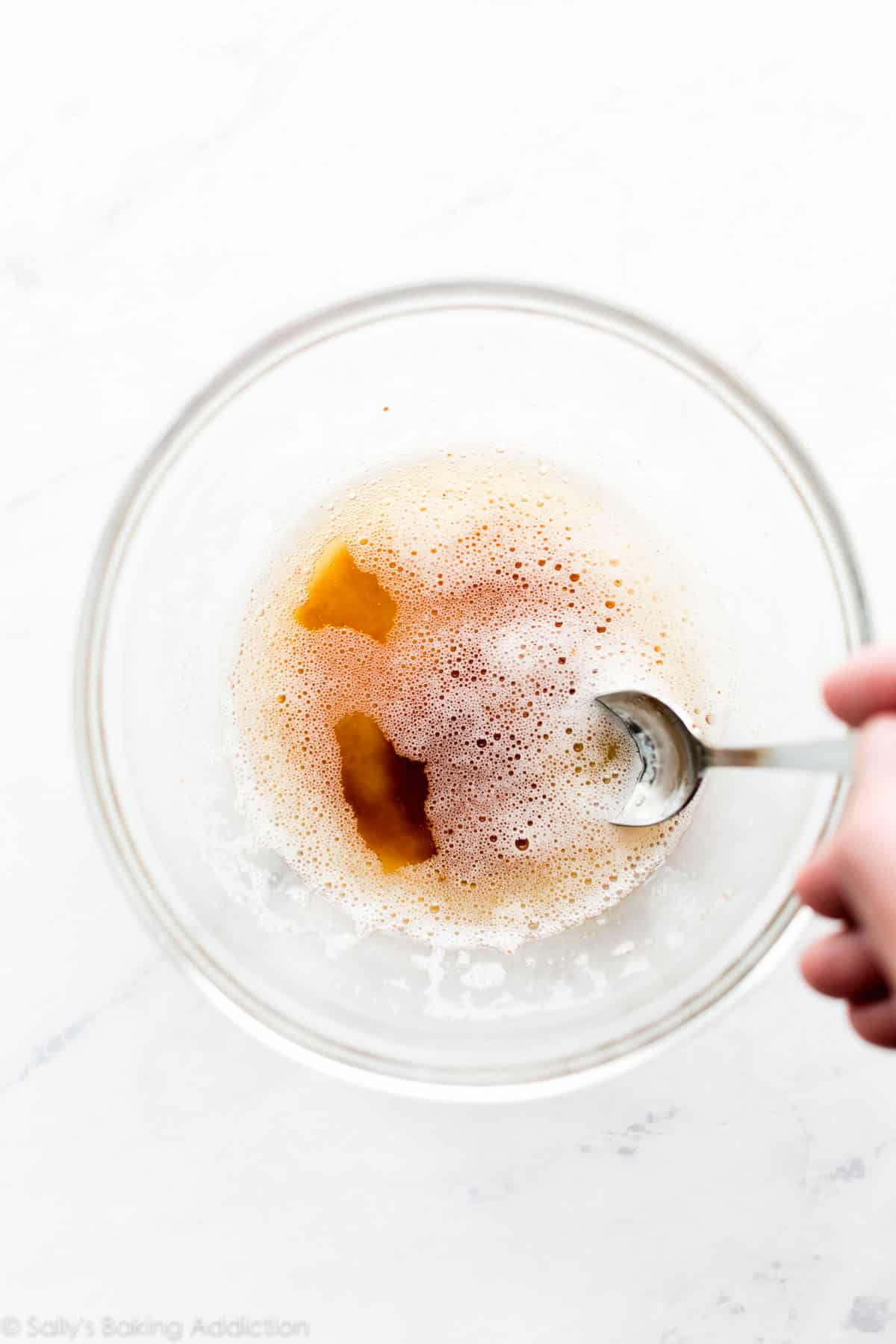





















I brown butter often; did it again just a few minutes ago. I also watched your video. My question is about the foam! Does the start temp of the butter make a difference? Today, my butter was a bit soft and there was so much foam that I really can’t see the color at the bottom. Once in a while, I don’t get as much foam, but there is still quite a bit. Any thoughts? Thank you.
Hi Paula! The start temp of the butter doesn’t matter. The “foam” is water content in the butter boiling (this can vary a little by brand) – make sure to keep whisking to prevent browning but also to pop those bubbles so you can keep an eye on the butter browning.
I browned the butter and added ground cumin. I served it with scallops and shrimp. Fantastic!
I tried to brown 1 cup of butter but it took such a long time (around 40mins)! And I don’t think it was even brown enough, still was yellow. Is it because of the amount of butter? What size pan would you recommend for browning 2 sticks of butter?
thank you! I used browned butter in my buckeyes and it was a wonderful decision 🙂
I just tried browning butter again for the 2nd time. The first time it really started to pop so I quickly removed it from the gas burner. Determined, I tried it again tonight; medium (gas burner) heat, stirring non stop, and it was an even larger disaster! I had melted butter exploding everywhere! I just don’t know what I am doing wrong. I’m a seasoned baker and cook. Help, please.
Hi Crystal, We’ve never had that happen but do have a few tips for you. Try cutting your butter into smaller pieces so that it all melts evenly. Lower your heat even more (even to low settings if medium was too hot), and don’t stop stirring. All of this should help for next time!
Sally, you continue to amaze me. Other recipes make browned butter seem more challenging but you give such simple and clear instructions. I never thought to use a light-colored bottomed pan. The only one I have is a soup pot but it worked! I was able to clearly see the specks start to brown in the pan. I think your instruction to “immediately remove the pan from heat and pour the butter into a heat-proof bowl to stop the cooking process” was another key to my success. I had never done this before but rather only turned the burner off. Using your recipe my browned butter turned out perfectly. Thank you!!!
Thank you so much for your positive feedback, Kristi! We’re thrilled this brown butter was a success for you.
Hey sally,
Isnt brown butter same as Ghee? Indian families make ghee out of butter so when I use your recipes can I just use ghee??
Thanks again
Hi Arpita! Brown butter and ghee have similarities, but are not the same. We wouldn’t recommend using them interchangeably in our recipes as they will have different flavors. This post from A Beautiful Plate about the differences between them may be helpful: https://www.abeautifulplate.com/clarified-butter-ghee-and-brown-butter/
I tried this one following through your steps and the result is magnificent! Who would have thought as a first time baker, I’d do it successfully!
How do we feel about freezing brown butter and grating it for scones? Is it crazy? Will it work? Anything I should know before experimenting?
Hi Kelly! We haven’t tried that, but don’t see why there would be any issues.Let us know how it goes!
I grate brown butter to make puff pastry and it works just like regular butter. No loss of flaky layers! I would think it should work for scones in the same way.
Hi, Sally
May I ask that brown butter can be use in brownie or not? It will give a better smell or nothing change.
And in case of brown butter provide a better taste for brownie baking, do I need to adjust anything in the current recipe?
Thx. in advance for your reply.
Hi Nu, you can certainly use brown butter in brownie recipes, but we find that the traditional deep, nutty taste can sometimes be overpowered and less prominent in chocolate-based goods. If you do choose to use it, follow the same amount as needed in the recipe and be sure to review this blog post about how to make up for the loss of moisture during the browning phase. You can use the melted brown butter right away if the recipe calls for melted butter, or chill in the fridge until it becomes solid if you recipe calls for solid, room temperature butter. Hope this helps!
Once you get the hang of browning butter, it becomes an addiction of adding it to recipes in place of regular butter because, “why not?”. I’ve found you just need to adjust (increase) the amount of butter used by the percentage of water content in the butter. I typically use Kerrygold unsalted butter for baking and it has about 15% water content, so for a recipe calling for 100g of regular butter, you would brown 118g (85% of 118g is 100g, rounding). The larger bubble stage of browning is all the water boiling off. Once that is done, you get the finer foam and browning starting. Doing the math also makes it easier to figure how much additional moisture to add back into the dough through milk, if necessary.
I made brown butter and used only the bits in the bottom of the pan for an ice cream. (great ice cream it is)
Can I still use the butter that I saved in the refrigerator in something like bread or cookies? or pie crust? I wasn’t sure if something about cooking the butter changed the chemistry needed for those other recipes? Thanks Love your site… my go to for baking. Angel food cake and yeast rolls on my agenda this weekend.
Hi Lisa! Yes you can use the extra butter in baking – it will add lovely flavor. Enjoy!
Thank you!
I made my first brown butter yesterday and made some cupcakes with it. Since I measure ingredients on a scale I had the exact amount called for in my recipe after browning additional butter. My problem was the cupcakes looked great until the last 3 minutes of baking when they sunk in the middle. I made certain they were fully baked so that wasn’t the issue. I made another batch adjusting some things I thought might be the problem, again they sunk, even worse than the first time. Please- are there specific adjustments to be made when substituting this butter? (They also had a somewhat course looking texture and were very dry next day).
Hi Barbara, you’ll definitely run into issues if the recipe you are using calls for softened butter and you are using browned (melted) butter. Are you chilling the browned butter to solidify it? Make sure you bring it to room temperature before using if the recipe calls for room temperature butter.
From the Video I find Preparation of brown butter is the same as preparing ghee.
This is an opinion question. I love the whole brown butter thing for things like pound cake, chocolate chip cookies. But I don’t see the point of using it in all-chocolate baked things, eg, brownies. I don’t find that it enhances the brownie quality. Is it just a matter of taste or is there a reason for using brown butter in brownies or chocolate cake? Thoughts? BTW I love your website
Hi KJ, definitely — in richer bakes that contain chocolate, espresso, etc., the brown butter taste can get a bit lost. In the end, it comes down to preference 🙂 Thanks for your question and positive feedback!
I’m confused, if a recipe calls for 1 stick of solid butter and I want to use brown butter, how much should I use since some will be lost through evaporation?
Hi Barbara, if it calls for room temperature butter just be sure your browned butter is cooled back to a solid state. Yes, you should brown a little more than the recipe calls for to ensure you have enough — about 1/2 tablespoon to 1 tablespoon extra to be safe. See the paragraph above called “Is there a loss of moisture?”
I’ve been making your chewy chocolate chip cookies for a long time and I came across this one. Can I sub the 3/4 cup butter (melted) with browned butter with the same amount or do I need to add more butter? If I need to add more, how much will it be?
Hi Denise, we suggest following this recipe for Brown Butter Chocolate Chip Cookies!
I browned two sucks this morning in preparation for cookies tomorrow morning. When they finally cooled it looks as though it separated into two layers, thin clearly brown and a thicker, darker than it started with yellow. Do I need to cook this further or is it done?
Hi Nick, that sounds perfectly normal for solidified brown butter. I wouldn’t cook it any more.
hello! how do i substitute brown butter for 1/2 cup of softened butter in a recipe? any tips? thank you so much!!
Hi Rozel, You can simply follow the directions for browning the butter and if it has been refrigerated let it sit at room temperature to soften up just like you would for for regular butter before using it in your recipe.
Holy, the brown butter is life changing. Never thought it could change the cream cheese flavour so much. I’ve also added in chocolate chips to make it more banana breadie 🙂
I do not have a light coloured pan. Is that essential?
It is not essential, it just makes it easier to see the color of the butter.
Browned butter is life changing! Just added to my favorite pecan pie recipe and it took to next level of nuttiness. I now have a jar in the fridge ready to use.
Hi. Thank you for this. I tried browning butter for the first time. The recipe called for 280g melted butter. I used the same amount of butter to brown, and ended up with lesser butter (because of the moisture loss). The cookies I made came out dry. So I tried it a second time, now using 400g of butter (just to make sure I had enough) and used 280g, as the recipe required. But the cookie still felt crumbly. Do I just add the 2 tbsp of milk to the 280g of browned butter (which I started with 400g) or do I use the same quantity of melted butter and add the 2 tbsp to what’s left after browning? Thank you so much.
Hi Juan, It’s hard to say without knowing which cookie recipe you are using. Are you using a recipe from this site? If the cookies are dry and you are using the correct amount, and the correct temperature, butter it’s likely something else happening. Be sure you measuring your ingredients properly, i.e. spoon and level (don’t scoop) your flour.
Once again, Sally, you’ve done it! Your step-by-step instructions, as well as the photographs, made this super easy. It’s absolutely delicious on butternut squash ravioli, pasta, and popcorn.
Question: I make cut-out sugar cookies decorated with royal icing. I’m tempted to use browned butter to see if I like the taste. If my recipe calls for two sticks of butter, would I need to melt additional butter prior to refrigerating and returning it to a solid state to ensure I have two sticks? Do you know if the butter behaves the same way as unbrowned butter at room temperature?
Thank you, in advance, for any advice that you might have!
Hi Mary, You should be able to use brown butter in place of regular butter in most cookie recipes. If it calls for room temperature butter just be sure your browned butter is cooled back to a solid state. Yes you should brown a little more than the recipe calls for to ensure you have enough. See the paragraph above called “Is there a loss of moisture?”
My brown bits on the bottom look black. Is that how they should look? It was hard to see the color of the butter through the foam. Do you use those brown/black bits in the frosting or do you strain them out?
Hi Mira, does the butter smell burnt? If so, it could have been cooked too long. You’re looking for brown bits, not black. Don’t strain out the brown bits before using the brown butter– they hold all the flavor!
I made browned butter for the first time yesterday – it sounded complicated and I was so nervous to do it, but in truth it was really easy! I flavoured it with a whole star-anise and added it to your Deep Dish Apple Pie filling – delicious! Thank you for a great tutorial Sally!
Do you keep the nutty solids on the bottom or strain? Thanks – you are our go to site and my kids are developing a love for baking (with me!)
Keep them in the butter! That’s where a lot of flavor is hiding.
Hi Sally,
Can I cook the browned butter, refrigerate it, then use it within a few days? Can it be frozen too? Thanks much.
Yes and yes! If you need the brown butter in its liquid state for a recipe, just melt it in the microwave before using.
I would love to make brown butter…everything! You make it sound delicious. However, we have dairy allergies in the family…any way of making brown butter (or getting the taste of) with anything else like coconut oil or margarine?
Hi Rachel, This is a great question and unfortunately I’m not sure! The wonderful nutty taste comes from the milk solids – which are obviously no going to work for you. My google search came up with many different options for browning dairy free butter but I haven’t tested any. Let me know if you do!
Thanks for the tutorial! It’s one of those things that seems fairly easy but has always made me nervous to attempt. Can’t wait to give it a try! Now to do some light colored pan shopping…